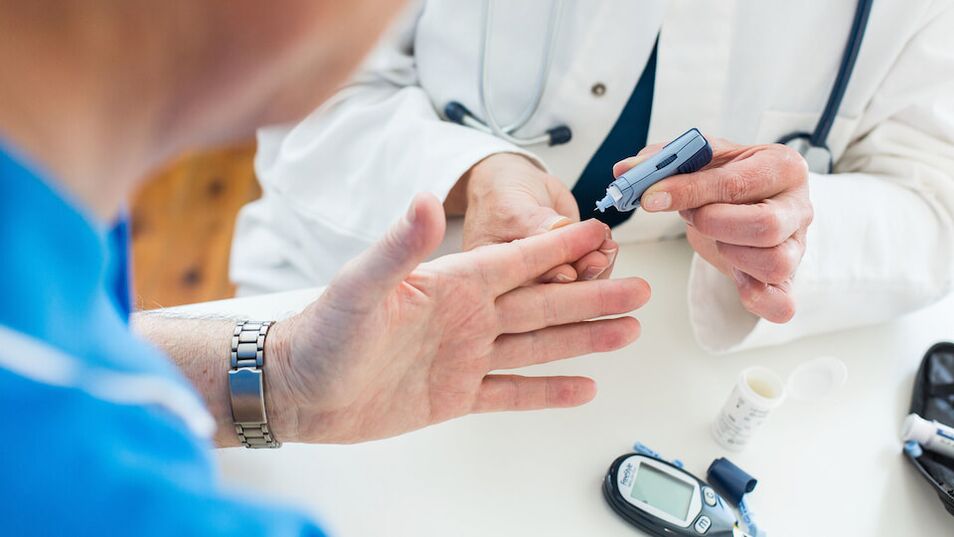Diabetes mellitus is a chronic endocrine disease that develops in people with insulin resistance and pancreatic dysfunction. Accompanied by persistent hyperglycemia. The patient is often thirsty, complaining of frequent emptying of the bladder. The disease is based on its own insulin deficiency on the basis of an increased level of glucose. In the context of diabetes, appetite is often disturbed, general health deteriorates, wounds and ulcers do not heal. The disease is chronic in nature and is characterized by continuous progression. Lack of therapy will lead to stroke, kidney failure, heart attack, and significant vision loss. Sharp fluctuations in blood sugar can cause a hyperglycemia or hypoglycemic coma.
Symptom

Diabetes develops gradually, in the early stages there may be no specific symptoms. Usually, violations are discovered by accident, during the next scheduled inspection.
Disease progression leads to complaints of:
- thirst and dry mouth
- insomnia
- cramps in the lower extremities
- itchy skin
- disabilities
- reduced emotional capacity
- urinating a lot and often
- increase taste
- dry skin and mucous membranes, filled with cracks, ulcerative lesions
- reduced eyesight.
Regeneration slows down: wounds, ulcers, cuts take a long time to heal. Sensitivity in the leg gradually decreases, until complete numbness. Progression of obesity is possible. As the disease spreads, leg hair begins to fall out, and facial hair may increase. Xanthomas are formed on the body - small yellow shapes.
Genitourinary system commonly suffers: vulvovaginitis is commonly diagnosed in women, and seminal vesicles in women. The metabolism is disturbed, the defense ability is reduced, the body is less resistant to infectious lesions. Prolonged lack of medical care can lead to osteoporosis. This is accompanied by complaints of pain in the joints and spine, deformities of the bones and violation of their integrity.
Reason
Diabetes mellitus is associated with tissue insulin resistance. This means they become less sensitive to the effects of insulin. At the same time, the plasma insulin level usually remains in the normal range and the glucose level rises significantly. The disease is usually diagnosed in patients of an older age group.
Among the factors that easily lead to violations, there are:
- genetic predisposition
- nutritional error
- heart-related diseaes
- chronic stress
- adrenal cortex failure
- excess weight
Diabetes can develop against the background of prolonged use of certain classes of drugs.
insulin resistance
Insulin resistance is a pathological condition that underlies the development of diabetes. In the body, the sensitivity of tissues to the action of insulin decreases. There may be no specific symptoms. Violation is accompanied by excess body weight, increased blood pressure.
In patients with progressive fatty liver noted, areas of hyperpigmentation may form on the skin: ringworm. To identify violations, it is necessary to go for blood tests for glucose, insulin, and HOMA. The basis of therapy is the adjustment of diet, moderate physical activity.
Overweight

Overweight people are at risk: adipose tissue blocks tissue sensitive to the effects of insulin. This is one of the important factors leading to the development of the disease. Overweight is detected in more than 89% of people with diabetes. The cause of such a violation can be the maintenance of a sedentary lifestyle, genetic predisposition, metabolic disorders. It is necessary to make a medical correction, to study the psychological state, to choose the right diet.
Tumor of the pancreas
Tumors of the pancreas can cause diabetes in people of different age groups. Usually, these tumors are benign and do not cause specific symptoms until they become large. Without timely treatment, it will lead to the transformation of a benign tumor into a malignant tumor. At the same time, the symptoms of general intoxication appear, the compression of surrounding organs is observed, and the vessels and nerves are damaged.
To confirm the diagnosis, the following diagnostic studies are performed:
- tumor markers
- CT scan
- Magnetic resonance imaging
- puncture
- biopsy
Treatment regimens are selected individually. In most cases, surgery is indicated. With malignancy of the pathological process, an additional course of chemotherapy and radiotherapy is prescribed.
Sedentary lifestyle
With a lack of motor activity, the mitochondria, the power stations of every cell in the body, suffer. This entails a disruption of the functioning of internal organs, a low mood and a tendency to depression. Many patients with diabetes tend to be stressed, rarely exercise. Even exercising for 15 minutes a day can trigger metabolism, improve the sensitivity of cells to insulin and reduce the risk of diabetes. If daily exercise isn't possible, go hiking in the fresh air at a brisk pace. You should walk and be in the fresh air for at least half an hour a day.
Heart-related diseaes
Under the influence of cardiovascular diseases, the sensitivity of tissues to insulin decreases and the risk of developing diabetes increases.
People who have been diagnosed with such disorders should be on high alert:
- atherosclerosis
- arterial hypertension
- coronary artery disease.
IHD is a damage to the heart muscle that occurs when there is not enough blood supply to the heart muscle. It is the most common cause of death, exceeding 75%. Often observed in patients with hypertension, hyperlipidemia, hypotension, obesity, as well as in smokers. It is important to treat the root cause of the disease promptly, with regular check-ups by a cardiologist.
Improper nutrition

One significant factor is the diet of the person with diabetes. They are prone to overeating, and at the same time suffer from nutritional deficiencies. They are often deficient in the following essential substances:
- minerals including chromium, selenium, manganese, iron, zinc, copper
- polyunsaturated fatty acids - healthy fats found in wild fish, buffalo milk, quality cold-pressed vegetable oils
- protein, which is the building material for new cells and tissues
- fat-soluble: vitamins A, E, D.
The diet is often dominated by carbohydrates and simple sugars, which negatively affect the intestinal microflora, reducing the protective properties of the body. If an excess of sugar and carbohydrates enters the body, this will increase glucose levels and overload the pancreas.
Endocrine disease
Diabetes mellitus can develop against the background of endocrine diseases:
- pancreatitis
- hypopituitarism
- hypothyroidism
- hyperthyroidism
- thyrotoxicosis
- dysfunction of the adrenal glands.
In this case, it requires a complex action on the root cause, the cause of diabetes. Patients are usually prescribed endocrine drugs: according to the schedule or regularly. It is also important to eliminate the source of stress, normalize sleep. It is important to ensure adequate intake of iodine, selenium, zinc and iron to ensure the normal functioning of the endocrine glands.
Infectious Diseases
Manifestations of diabetes mellitus are often observed with a long-standing progressive infectious disease:
- Herpes
- Hepatitis
- Herpes
Chronic infections weaken the body's defenses, leaving the body vulnerable to other diseases. The main manifestation of hepatitis can become a symptom of a viral disease. In this case, it is important to work with the root cause - the source of infection and reduce the viral load on the body. To do this, use antiviral, immunostimulating, symptom-modifying drugs.
Medicine
Certain classes of drugs can also cause the manifestations of diabetes in the elderly or middle-aged.
The risk group includes people:
- Synthetic corticosteroids
- diuretic
- cytostatic drugs
The drug can be taken only on the prescription of a doctor. If drugs that cause insulin resistance increase the risk of developing diabetes, the indications, dose adjustments, and alternative methods should be reviewed. It is impossible to self-prescribe or stop taking the drug, as this can aggravate the course of the underlying disease, to treat the described drugs.
Chronic adrenal insufficiency
Adrenal insufficiency often leads to the development of diabetes. It occurs in patients who do not secrete enough hormones by the adrenal glands. Characteristic symptoms: copper pigmentation on the skin, mucous membranes, feeling of weakness, vomiting, diarrhea, impaired consciousness. Accompanied by water and electrolyte disturbances, cardiovascular system dysfunction. The treatment is carried out in a complex way: the root cause is removed, corticosteroids, symptomatic drugs are used.
Possible complications

Lack of timely treatment of diabetes can lead to complications such as:
- Diabetic vascular disease - increased vascular permeability, increased risk of thrombosis, cardiovascular diseases.
- Diabetic foot - occurs against the background of circulatory disorders in the lower extremities.
- Nutritional ulcer of the lower extremities.
- Diabetic polyneuropathy, a condition that affects the peripheral nerves, occurs in more than 70% of patients with diabetes. Over time, polyneuropathy can turn into neuropathy. This complication is rare but requires prompt, high-quality medical care.
- Diabetic nephropathy, in which it impairs the blood supply to the vessels of the kidneys and increases the likelihood of developing kidney failure.
- Diabetic coma is the most dangerous complication leading to death.
Hyperglycemia occurs when there is a significant increase in the amount of glucose in the blood. This is accompanied by weakness, general malaise, loss of appetite, headache. If appropriate measures are not taken, the patient begins to experience nausea, vomiting with an odor of acetone. Reduce abdominal pain, lower blood pressure. To prevent dangerous complications, it is important to initiate insulin resistance/diabetes treatment promptly and to continuously monitor blood glucose levels. It is not possible to choose medications on your own as they may not have the proper treatment outcome and cause complications.
Which doctor to contact?
At the first symptoms of diabetes, it is advisable to consult an endocrinologist. The doctor will conduct a comprehensive diagnosis using laboratory and instrumental techniques, which will determine the extent of the progression of the disorder. In the future, it may be necessary to consult other doctors: a cardiologist, a nutritionist, an oncologist, a gynecologist. It's important to follow all of your doctor's instructions and not buy your own medicine.
Diagnose

To confirm the diagnosis, the doctor prescribes a comprehensive diagnosis:
- fasting blood sugar
- Ketone body and urine sugar
- glycosylated hemoglobin
- C-peptide
- insulin
- glucose tolerance test.
To determine the amount of sugar in the urine, special test strips are used. In order to timely detect complications of diabetes, it is recommended to conduct ultrasound of the kidneys, angiography of the extremities, and at the same time check the structural and functional state of the brain.
Treatment
The treatment regimen is selected for each patient. At the same time, age, concomitant chronic diseases, somatic are also taken into account. Therapy is carried out for life, the patient must be under the constant supervision of an endocrinologist. In the early stages, they reviewed their diets, reducing the number of meals.
Optimal is two meals a day, no snacks. Breakfast with healthy fats, proteins, carbohydrates can be obtained from vegetables. Bread products, other sources of sugar and simple carbohydrates are completely eliminated from the diet. The servings are small, providing a feeling of fullness due to the balanced composition and the presence of fat.
Drug modification involves the use of the following classes of drugs:
- blood sugar lowering drugs
- drugs that restore blood circulation and microcirculation
- high blood pressure medication (if indicated)
Treatment regimens are selected individually and often supplemented with vitamin-mineral complexes, amino acids: taurine, glycine. Medicines will not completely eliminate the problem. Patients should have a responsible attitude towards lifestyle modifications and adhere to all physician recommendations.
Diabetics are shown moderate physical activity. This avoids further progression of the pathological process and the development of complications. Encourage daily walking, yoga, swimming, gymnastics, breathing exercises. The best option - classes under the supervision of an instructor. It is advisable to discuss with your doctor in advance the volume of the load.
Prevent

To prevent diabetes, it is important to monitor the diet, normalize body weight, eliminate the source of stress, restore the regime of work, rest, sleep. It is important to review the diet, including adequate amounts of healthy fats, fiber, and reduced intake of simple carbohydrates. It is important to restore sleep: go to bed no later than 11 pm, sleep in a cool, dark room.
Pay particular attention to physical activity: daily walks in the fresh air, running, brisk walking, swimming, and any other type of appropriate and feasible physical activity. Physical activity is unacceptable and may exacerbate insulin resistance. Breathing practice is very helpful: breathing pranayama, Buteyko, to ensure an adequate supply of oxygen to the tissues.
People and risk groups are recommended to monitor indicators of glucose and glycosylated hemoglobin, insulin. At the first sign of a violation, refuse to self-medicate and go to an experienced endocrinologist.
The prognosis for patients who promptly seek medical help and readjust their lifestyle is mostly favorable. They can live long, quality lives without facing dangerous complications of the disease. The lack of therapy leads to reduced life expectancy and the development of acute/chronic complications.



























